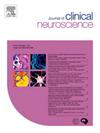Repeat stereotactic radiosurgery in vestibular schwannoma patients: A systematic review and meta-analysis
IF 1.9
4区 医学
Q3 CLINICAL NEUROLOGY
引用次数: 0
Abstract
Background
Regarding the newly diagnosed vestibular schwannomas (VSs), active surveillance, microsurgical resection (MS), and stereotactic radiosurgery (SRS) are the leading treatment options. Although SRS is an effective intervention with a low incidence of complications, failure may occur occasionally. Several options, including repeat SRS, are considered salvage treatment after failure of the SRS. In this systematic review and meta-analysis study, we aimed to evaluate the efficacy and outcomes of repeat stereotactic radiosurgery (SRS) in progressive VS following the failure of the initial SRS.
Method
The electronic databases of PubMed/Medline, Scopus, Embase, and Web of Science (WOS) were searched from inception to August 23rd, 2024. Studies that evaluated the role of repeat SRS in the setting of VS were included. The risk of bias was assessed using the Risk of Bias in Non-Randomized Studies of Interventions tool. The R program performed the meta-analyses, sensitivity analysis, publication bias, and meta-regression.
Results
A total of 11 studies encompassing 260 VS patients with repeat SRS were included in our study. The median time interval between initial and repeat SRSs ranged from tumor volume ranged from 43 to 62 months. Our analysis revealed a pooled tumor control of 91 % (95 % CI: 86 %-94 %). Regarding the radiological response, the pooled regression rate was 59 % (95 % CI: 52 %- 65 %), while the pooled progression rate was 9 % (95 % CI: 6 %- 14 %). Regarding the clinical outcomes, the pooled serviceable hearing preservation (SHP) rate was 36 % (95 % CI: 22 %-53 %), while worsened fifth cranial nerve (CN) and seventh CN rates were 12 % (95 % CI: 7 %- 19 %) and 8 % (95 % CI: 5 %- 12 %), respectively. In addition, the pooled adverse radiation effect (ARE) rate was 6 % (95 % CI: 3 %- 11 %).
Conclusion
Our results suggest that the repeat SRS following the failure of the initial SRS in VS is associated with favorable outcomes, including tumor control, SHP, and CN worsening concurrent with low ARE rates.
前庭分裂瘤患者的重复立体定向放射外科治疗:系统回顾和荟萃分析
背景对于新确诊的前庭分裂瘤(VSs),积极监测、显微外科切除术(MS)和立体定向放射外科手术(SRS)是主要的治疗方法。虽然 SRS 是一种并发症发生率较低的有效干预方法,但偶尔也会出现失败。包括重复 SRS 在内的几种方案被认为是 SRS 失败后的挽救治疗。在这项系统性综述和荟萃分析研究中,我们旨在评估重复立体定向放射手术(SRS)对初次 SRS 失败后进展期 VS 的疗效和结局。方法检索了 PubMed/Medline、Scopus、Embase 和 Web of Science (WOS) 等电子数据库中从开始到 2024 年 8 月 23 日的内容。纳入了评估VS情况下重复SRS作用的研究。使用 "非随机干预研究中的偏倚风险"(Risk of Bias in Non-Randomized Studies of Interventions)工具对偏倚风险进行了评估。R程序进行了荟萃分析、敏感性分析、发表偏倚和荟萃回归。结果 我们的研究共纳入了11项研究,包括260名VS患者的重复SRS。首次SRS和重复SRS之间的中位时间间隔从肿瘤体积的43个月到62个月不等。我们的分析显示,肿瘤控制率为 91%(95% CI:86%-94%)。在放射学反应方面,总回归率为 59 %(95 % CI:52 %- 65 %),而总进展率为 9 %(95 % CI:6 %- 14 %)。在临床结果方面,合并听力保留率(SHP)为 36%(95% CI:22%-53%),第五颅神经(CN)和第七颅神经恶化率分别为 12%(95% CI:7%- 19%)和 8%(95% CI:5%- 12%)。结论我们的研究结果表明,VS 初次 SRS 失败后再次进行 SRS 与良好的结果相关,包括肿瘤控制、SHP 和 CN 恶化,同时 ARE 发生率较低。
本文章由计算机程序翻译,如有差异,请以英文原文为准。
求助全文
约1分钟内获得全文
求助全文
来源期刊

Journal of Clinical Neuroscience
医学-临床神经学
CiteScore
4.50
自引率
0.00%
发文量
402
审稿时长
40 days
期刊介绍:
This International journal, Journal of Clinical Neuroscience, publishes articles on clinical neurosurgery and neurology and the related neurosciences such as neuro-pathology, neuro-radiology, neuro-ophthalmology and neuro-physiology.
The journal has a broad International perspective, and emphasises the advances occurring in Asia, the Pacific Rim region, Europe and North America. The Journal acts as a focus for publication of major clinical and laboratory research, as well as publishing solicited manuscripts on specific subjects from experts, case reports and other information of interest to clinicians working in the clinical neurosciences.
 求助内容:
求助内容: 应助结果提醒方式:
应助结果提醒方式:


